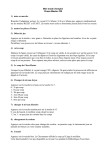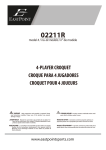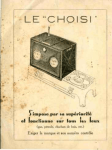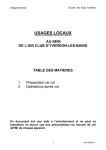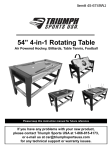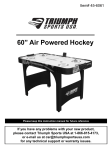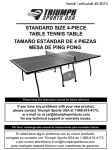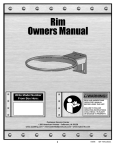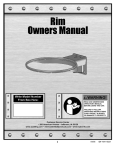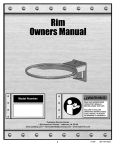Download CROQUET
Transcript
SP35-7200 Series Croquet Sets CROQUET INSTRUCTION MANUAL AND GAME RULES CROQUET GAME RULES Object of Game To have your side’s ball(s) score more wickets than your opponent. In a time limit game, the winner is the side with the most points at the end of time (each wicket scored by a ball is one point). The object of the game is to advance the balls through the course by hitting them with a mallet, scoring a point for each wicket and stake made in the correct order and direction. The winner is the first side to score the 14 wicket points and 2 stake points for each of its balls, unless the game is played to a time limit and time runs out before that happens, in which case the team with the most points at the end of the time period wins. The players take turns, and only one plays at a time. At the beginning of a turn the player (called the “striker”) has one shot. After that shot the turn ends, unless a bonus shot is earned by scoring a wicket or stake or by hitting another ball. The turn ends when the player has no more bonus shots to play or has finished the course by scoring the finishing stake. The striker may directly hit with the mallet only the ball he or she is playing in that turn (the “striker ball”). 8 7 9 6 10 5 11 4 12 3 13 14 2 1 Croquet can be played as a singles game (either one or two balls on a side), doubles (each player has a partner playing his/her own ball), or triples using six balls (six players in the game – either three teams of two players or two teams of three players.) 1 SP35-7200 Spalding Croquet Series CROQUET GAME RULES (continued) Sequence of Play Follow the colors on the stakes. Starting Point All balls are played into the game from a spot halfway between the finishing stake and the first wicket. Scoring Each ball can score wicket and stake points for its side only by going through a wicket or hitting a stake in the proper order and direction. Going through a wicket out of order or in the wrong direction is not counted as a point gained or lost. A ball caused to score its wicket or stake during another ball’s turn earns the point for its side, but no bonus shot is earned as a result. A ball scores a wicket point only if it comes to rest clear of the playing side of the wicket. If a ball passes through a wicket but rolls back, it has not scored the wicket. An easy way to determine if a ball has cleared a wicket is to run the side of the mallet head down the plane of the playing side of the wicket. If the mallet head touches the ball on the way down, it has not cleared the wicket; if the mallet head does not touch the ball, it has cleared the wicket. Rover Ball If you score all the wickets you are a rover. A rover helps his/her side’s ball(s) while hindering the opponent’s balls. A rover may roquet all the balls only once per turn. Any ball can cause the rover ball to hit the finishing stake thereby removing it from the game. Bonus Shots: The striker earns one bonus shot if the striker ball scores a wicket or hits the turning stake. The striker earns two bonus shots if the striker ball hits another ball (a “roquet”). However, the maximum number of bonus shots earned by a striker is two; there is never a time when a striker is allowed three shots. (See the “Exceptions” section on next page for examples.) If two bonus shots are scored by striking another ball, the first of these two shots may be taken in any of four ways: — From a mallet-head distance or less away from the ball that was hit (“taking a mallet-head”). — From a position in contact with the ball that was hit, with the striker ball held steady by the striker’s foot or hand (a “foot shot” or “hand shot”). SP35-7200 Spalding Croquet Series 2 CROQUET GAME RULES (continued) — From a position in contact with the ball that was hit, with the striker ball not held by foot or hand (a “croquet shot”). — From where the striker ball stopped after the roquet. The second bonus shot after a roquet is an ordinary shot played from where the striker ball came to rest, called a “continuation shot”. Bonus shots may not be accumulated. Upon earning a bonus shot by scoring a wicket, hitting the turning stake, or roqueting another ball, any bonus shot previously earned is forfeited. For example, if a ball roquets a ball and in that same stroke the striker ball hits another ball, the second ball hit is not a roquet and remains where it comes to rest. Exceptions: Two extra shots are earned when the striker ball scores two wickets in one shot. If the ball also hits the turning stake after scoring two wickets, two strokes are earned, not three. Conversely, if the striker ball scores the seventh wicket and hits the turning stake in the same shot, it earns two shots. After the striker ball roquets another ball, it does not earn any extra shots for hitting it again in the same turn before scoring the next wicket in order. However, there is no penalty for hitting the ball again. 3 SP35-7200 Spalding Croquet Series COURT LAYOUT Set up wickets/stakes as shown in the diagram. Try to keep the space between the stake and the two beginning and turnaround wickets at least 3 feet. TYPICAL BACKYARD COURT 25' Placement of Wickets and Stakes The nine wickets and two stakes are arranged in a double-diamond pattern as shown in the diagram. If you are playing on a smaller court, the distances shown should be scaled down in proportion to the length and width of the court. Arrange to keep the distance between the stake and wicket 1 and wicket 2 three feet at a minimum. Same goes for wickets 6-7 and far stake. The wickets should be firmly planted in the ground, and the width of the wickets should be uniform throughout the court. The court can take any shape to fit your playing area. Bending around obstacles in the yard like trees or going around a corner of the house can add to the fun. Boundaries are optional. 9' Center of Court 50' 8' 3' 8' 3' 3' 3' Optional boundary SP35-7200 Spalding Croquet Series 4 CROQUET TERMINOLOGY Bonus Strokes The stroke(s) earned by either going through a wicket or striking another ball with one’s own ball. Roquet [ ro• káy ] A stroke in which the striker’s ball hits another ball upon which it is entitled to take bonus strokes. Rover Player and ball that has passed through all wickets but has not hit the starting post to finish play. Once through all wickets the rover may travel in any direction and through any wicket. When playing teams players may elect a rover to help their teammates complete the circuit. Once the ball has struck the starting post the game is over for that player. Stake The most common name for the peg in the middle of the six-wicket court or on either end of the 9-Wicket or Backyard court. Wickets The metal or wire openings set in the lawn through which points are made, also called “hoops”. 5 SP35-7200 Spalding Croquet Series CUSTOMER SERVICE HOURS: Monday – Friday 9:30am to 6:00pm EST Call: 866.815.4173 Email: [email protected] Website: www.triumphsportsusa.com Limited 90-Day Warranty - Triumph Sports USA, Inc. All Spalding® licensed and Triumph Sports USA, Inc. (TSU) games have a limited 90-day from date of purchase warranty. This warrants the retail purchaser for any TSU game purchased to be free from any defect in materials and construction for 90 days from the date of purchase. Normal play wear and usage is not covered under the warranty, nor is wear or damage due to improper use of the TSU game. This will void any and all TSU warranties. A PURCHASE RECEIPT (or other proof of purchase date) will be required before any warranty service is initiated. All requests for warranty service can be submitted by email, in writing or by contacting our Customer Service Department at: 1-866-815-4173 or email us at [email protected]. IMPORTANT NOTICE! Please contact us before returning the product to the store. SP35-7200 Spalding Croquet Series 6 7 SP35-7200 Spalding Croquet Series SP35-7200 Spalding Série Croquet SÉRIE DE COMPÉTITION/DE LOISIR CROQUET MANUEL D’INSTRUCTIONS ET RÈGLES DU JEU RÈGLES DU JEU DE CROQUETS Le but du jeu Il consiste pour chaque camp à passer plus de boules sous les arceaux que le camp adverse. Dans une partie à temps limité, le camp gagnant est celui ayant le plus e points à la fin du temps imparti (chaque boule qui passe un arceau compte pour un point). Le but du jeu consiste à faire avancer les boules sur le parcours en les frappant avec un maillet, marquant un point pour chaque arceau et piquet dans l’ordre et le sens corrects. Le camp gagnant est le premier à passer les 14 points d’arceau et les 2 points de piquet pour chacune de ses boules, sauf si la partie a un temps limité et que le temps se termine avant que ce nombre de points ne soit atteint, auquel cas l’équipe ayant le plus de points à la fin du temps imparti est déclarée gagnante. 8 7 9 6 10 5 11 4 12 3 Les joueurs jouent à tour de rôle, 13 un joueur à la fois. Au début de son tour, le joueur (appelé « attaquant ») dispose d’un coup. Une fois le coup 14 joué, le tour est terminé, sauf si le 2 joueur gagne un coup supplémentaire en passant un arceau ou un piquet ou en frappant une autre boule. Le 1 tour se termine lorsque le joueur n’a plus de coups supplémentaires à jouer ou a achevé le parcours en frappant de sa boule le piquet d’arrivée. Le joueur ne peut frapper directement avec le maillet que la boule qu’il est en train de jouer pendant son tour (la « boule du joueur »). Le croquet peut se jouer en parties simples (une ou deux boules sur un côté), doubles (chaque joueur a un partenaire qui joue sa propre boule) ou triples avec six boules (six joueurs dans la partie : trois équipes de deux joueurs ou deux équipes de trois joueurs). 9 SP35-7200 Spalding Croquet Series RÈGLES DU JEU DE CROQUET (suite) Ordre du jeu Suivre les couleurs des piquets. Point de départ Toutes les boules se jouent à partir d’un point situé à mi-chemin entre le piquet d’arrivée et le premier arceau. Décompte des points Une boule ne peut marquer des points d’arceau et de piquet qu’en passant sous un arceau ou en frappant un piquet dans l’ordre et le sens appropriés. Une boule qui passe un arceau sans suivre l’ordre indiqué ou dans le mauvais sens ne compte pas comme point gagné ou perdu. Une boule qui marque son arceau ou son piquet pendant le tour d’une autre boule gagne le point pour son camp, mais cela ne donne droit à aucun coup supplémentaire. Une boule ne marque un point d’arceau que si elle s’arrête clairement au-delà de l’aire de jeu de l’arceau. Si une boule passe sous un arceau puis roule en arrière, le point n’est pas marqué. Pour déterminer facilement si une boule a passé un arceau, il suffit de mettre la tête du maillet au niveau de l’aire de jeu de l’arceau. Si la tête du maillet touche la boule, celle-ci n’a pas passé l’arceau; si la tête de maillet ne touche pas la boule, celle-ci a passé l’arceau. Boule de rover Si vous avez passé la boule sous tous les arceaux, vous êtes un rover. Un rover aide au passage des boules de son camp tout en gênant les boules de l’adversaire. Un rover peut « roquer » toutes les boules une seule fois par tour. Si une boule frappe la boule du rover contre le piquet d’arrivée, celle-ci doit être retirée du jeu. Coups supplémentaires: Le joueur gagne un coup supplémentaire si sa boule passe sous l’arceau ou frappe le piquet de détour. Le joueur gagne deux coups supplémentaires si sa boule frappe une autre boule (un « roquet »). Cependant, le joueur ne peut gagner que deux coups supplémentaires au maximum; à aucun moment il ne peut avoir trois coups. (Voir la section « Exceptions » à la page suivante pour les exemples.) Si deux coups supplémentaires sont marqués en frappant une autre boule, le premier de ces deux coups peut être frappé de l’une des quatre façons suivantes : — À une distance d’une tête de maillet ou inférieure par rapport à la boule frappée (« prise d’une tête de maillet »). SP35-7200 Spalding Série Croquet 10 RÈGLES DU JEU DE CROQUET (suite) — Depuis une position de contact avec la boule qui a été frappée, le joueur tenant sa boule en position stable par le pied ou la main (un « coup au pied » ou un « coup à la main ») — Depuis une position de contact avec la boule qui a été frappée, sans que le joueur tienne sa boule par le pied ou la main (un « coup de croquet ») — Depuis l’endroit où la boule s’est arrêtée après le roquet. Le deuxième coup supplémentaire après un roquet est un coup ordinaire joué à partir de l’endroit où la boule du joueur s’est arrêtée; il est appelé « coup de continuation ». Les coups supplémentaires ne peuvent pas être accumulés. Après avoir gagné un coup supplémentaire en faisant passer la boule sous un arceau, en frappant le piquet de détour ou en frappant par roquet une autre boule, le joueur perd tout coup supplémentaire gagné auparavant. Par exemple, si une boule frappe par roquet une autre boule et que par le même coup la boule du joueur frappe une autre boule, la deuxième boule frappée n’est pas un roquet et reste dans la position où elle s’est arrêtée. Exceptions: Deux coups supplémentaires sont gagnés lorsque la boule du joueur passe sous deux arceaux d’un seul coup. Si la boule frappe aussi le piquet de détour après être passée sous deux arceaux, deux coups sont gagnés, non trois. Inversement, si la boule du joueur passe sous le septième arceau et frappe le piquet de détour du même coup, deux coups supplémentaires sont gagnés. Après que la boule du joueur a frappé par roquet une autre boule, aucun coup supplémentaire n’est gagné si elle est frappée à nouveau dans le même tour avant de passer l’arceau suivant dans l’ordre établi. Cependant, frapper la boule à nouveau ne donne lieu à aucune pénalité. 11 SP35-7200 Spalding Série Croquet DISPOSITION DU TERRAINT Disposez les arceaux et les piquets comme illustré dans le schéma. Essayez de garder un espace d’au moins 90 cm (3 pieds) entre le piquet-but et les deux arceaux de départ et de retour TERRAIN D’ARRIÈRE-COUR TYPIQUE 25' Positionnement des arceaux et des piquets Les neuf arceaux et les deux piquets sont disposés en forme de double diamant comme illustré dans le schéma. Si vous jouez sur un petit terrain, les distances illustrées doivent être adaptées en fonction de la longueur et de la largeur du terrain. Essayez de garder une distance d’au moins 90 cm (3 pieds) entre le piquet et l’arceau 1 et l’arceau 2. La même recommandation s’applique à la distance entre les arceaux 6 et 7 et le piquet d’arrivée. Les arceaux doivent être fermement plantés au sol et leur largeur doit être égale sur tout le terrain. Le terrain peut prendre n’importe quelle forme pour être adapté à votre aire de jeu. Vous pouvez faire le tour des obstacles dans la cour, tels que les arbres, ou contourner le coin de la maison pour plus de plaisir. Les frontières sont facultatives. SP35-7200 Spalding Série Croquet 9' Centre de cour 50' 8' 3' 8' 3' 3' 3' Borne facultative 12 TERMINOLOGIE DU CROQUET Coups supplémentaires Les coups gagnés en faisant passer la boule sous un arceau ou en frappant une autre boule avec sa propre boule Roquet [ ro• káy ] Une rappe dans laquelle la boule de la butée frappe une autre boule sur laquelle il est autorisé pour prendre des rappes de bonification. Rover Joueur et boule ayant passé à travers tous les arceaux, mais sans toucher le piquet de départ pour terminer le jeu. Une fois passé sous tous les arceaux, le rover peut évoluer dans n’importe quel sens et à travers n’importe quel arceau. Lors du jeu, les joueurs peuvent élire un rover pour aider leurs coéquipiers à achever le parcours. Une fois que la boule a frappé le piquet de départ, le jeu est terminé pour ce joueur. Piquet Le nom qui désigne généralement le piquet situé au milieu du terrain de six arceaux ou à l’une des extrémités du terrain de 9 arceaux ou d’arrière-cour. Arceaux Les portillons en métal ou en treillis plantés dans le gazon, à travers lesquels les points sont marqués. 13 SP35-7200 Spalding Série Croquet HEURES DE TRAVAIL DU SERVICE À LA CLIENTÈLE: du lundi au vendredi, de 9h30 à 18h00 HNE Téléphone : 866 815 4173 Courriel : [email protected] Site Web : www.triumphsportsusa.com Fabriqué avec l’autorisation de Russell Brands, LLC. Les marques de commerce SPALDING, « S » et/ou « True to the Game » sont utilisées avec l’autorisation de Russell Brands, LLC. GARANTIE LIMITÉE DE 90 JOURS - Triumph Sports USA, Inc. Tous les jeux autorisés sous licence de Spalding® et de Triumph Sports USA, Inc. (TSU) sont couverts par une garantie limitée de 90 jours à partir de la date d’achat. Cela garantit à l’acheteur au détail que le jeu TSU est exempt de tout défaut de matériaux et de fabrication pendant 90 jours à partir de la date d’achat. L’usure et l’utilisation normales du jeu ne sont pas couvertes par la garantie. Ne sont pas également couverts l’usure et les dommages dus à une utilisation inappropriée du jeu TSU. Cela annulera partiellement ou totalement les garanties TSU. Un REÇU D’ACHAT (ou un autre justificatif de la date d’achat) sera requis pour toute intervention sous garantie. Toutes les demandes d’intervention sous garantie peuvent être envoyées par courriel, par courrier postal ou en communiquant avec le Service à la clientèle au: 1-866-815-4173 ou en nous écrivant à l’adresse [email protected]. AVIS IMPORTANT! Veuillez communiquer avec nous avant de retourner le produit au magasin. SP35-7200 Spalding Série Croquet 14 SP35-7210 / SP35-7211 Manufactured under license from Russell Brands, LLC. The SPALDING, “S”, and/or “True to the Game” trademarks are used under license from Russell Brands, LLC. © 2015 Russell Brands, LLC. Triumph Sports USA, Inc. 11327 West Lincoln Avenue West Allis, WI 53227 www.triumphsportsusa.com 866.815.4173
















